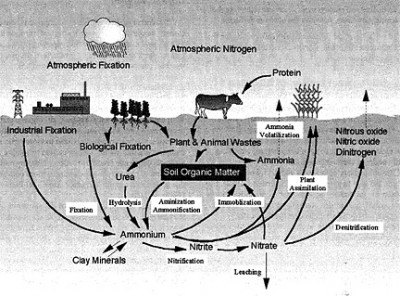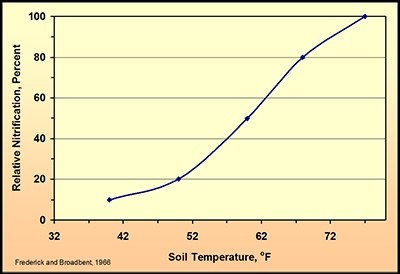Early Season Garlic Fertility
Crystal Stewart-Courtens, Extension Vegetable Specialist
Eastern New York Commercial Horticulture
The most important time to make nitrogen available to a garlic plant in order to increase yield is shortly after leaf emergence from the ground. Success in providing optimal nitrogen will depend on the nitrogen source you are using and some well-timed assistance from soil biology.
Remember that the nitrogen cycle is driven by biology, and biology is driven by temperature (and soil health!). Organic matter is decomposed partially into ammonium by a suite of microbes before nitrification (see Figure 1 for a handy visual). As the soil warms, N that is bound in organic matter (slow release N) will be made available, and ammonium nitrogen will turn to nitrate nitrogen (Figure 2), which is easily taken up by plants.
Bare ground garlic growers can apply their nitrogen in the spring using a variety of sources including very soluble nitrate-nitrogen forms, because the plant will take up the fertilizer readily now. Our latest research is showing that garlic needs no more than 50 lbs/A of N applied in a spring sidedressing.
Nitrogen applied later in the growing cycle of garlic has very little if any effect on the final bulb size. So if you haven't applied your N yet, now is the time!
Figure 1: Nitrogen cycling, including organic and inorganic forms.
Figure 2: relationship of nitrification to soil temperature. As temperatures climb, nitrifying bacteria more quickly convert ammonia forms of N to nitrate forms, which are more plant available but also more prone to leaching.
This article is from the April 26, 2018 edition of ENYCHP Vegetable News. To read the full newsletter,CLICK HERE.

Figure 1

Figure 2

Upcoming Events
ENY Orchard Soil Health and Beneficial Fungi Meeting
August 15, 2024 : ENY Orchard Soil Health and Beneficial Fungi Meeting
Peru, NY
Join the members of CCE ENYCHP and the Cornell Soil Health Program for a field meeting on the basics of soil health, the potential benefits of mycorrhizal fungi, and an update on the current project status of our SARE grant on orchard mycorrhizal products.
This meeting is intended for farmworkers, young and beginning orchardists, and experienced orchard managers wanting to learn about the basics of soil health and mycorrhizal fungi within the orchard.
North Point Community Farm Twilight Meeting
August 19, 2024 : North Point Community Farm Twilight Meeting
Plattsburgh, NY
North Point Community Farm Twilight Meeting
Monday, August 19th 4-7 pm (rain or shine)
2172 Military Turnpike, Plattsburgh, NY 12901
$10 per farm
Join us for a tour of North Point Community Farm, a diversified vegetable, berry, and flower operation in the North Country. Farmers Marisa and Mike will give us an overview of their decision-making as they expand their business, increasing their high tunnel production, investing in new tillage equipment, and transforming an old dairy barn into an efficient wash-pack shed with food safety in mind. We'll end the evening with local food refreshments and an opportunity to network with growers from NY and VT.
DEC credits: 1.5 credits in categories 1A, 10, 23
Late Summer Orchard Meeting
August 21, 2024
Fonda, NY
Join us for our last get together of the summer before we're in the thick of harvest. At this meeting, we will tour Sand Flats Orchard with manager Mitch Hoffman, and we will then discuss late season pest management tasks with our experts from the HVRL and Cornell AgriTech.
DEC Credits: 1.5 credits in categories 1A, 10, and 22.












































